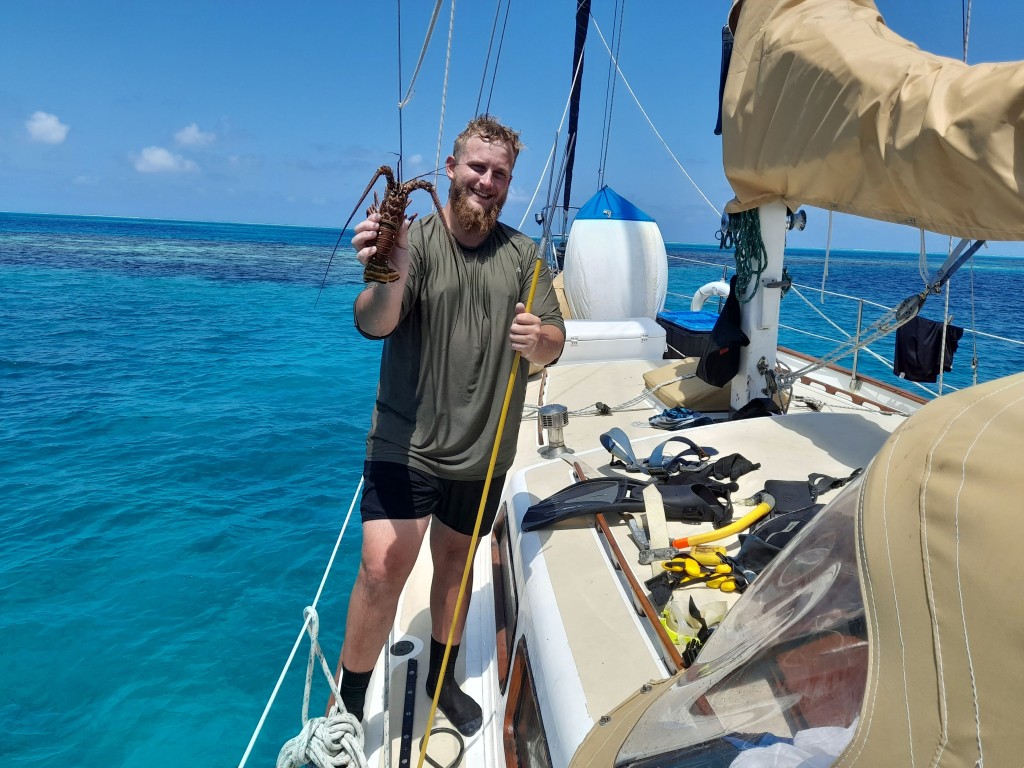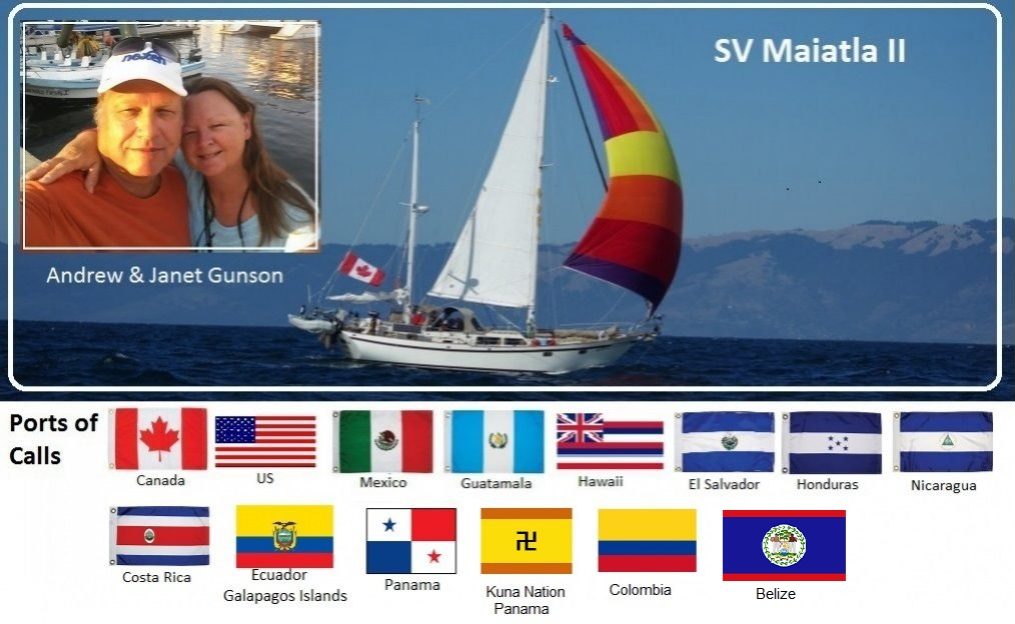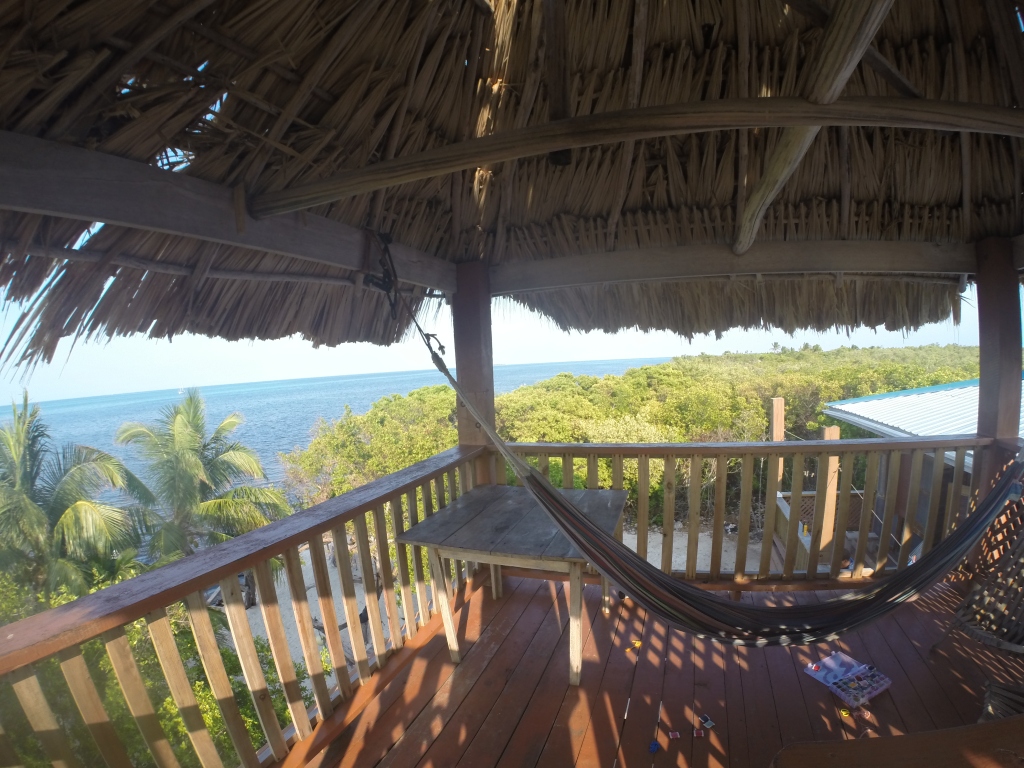Easton and I were still sitting at the bar having beers when one of the dive boats arrived to disgorge a dozen or so exhausted looking divers. Amongst them was a tall black man that the cook identified as the manager and head dive master. With a female companion, he found a table near the bar. I marched over to introduce myself then explained what we were doing there while expressing my appreciation for the help his staff had provided while making my pump repairs.

He seemed pleasant enough but was more focused on the young lady in his company than what I had to say. In a few days’ time, I would learn that her name was Susan and was a diver from Montreal and here for a week. I tried to pick the managers brains about some of the better dive spots on the atoll, but he was not too talkative, to me anyways. Shaking his hand I then returned to my own table.
Earlier Easton had expressed an interest in learning how to scuba dive so he could dive with me when we reached the blue hole. I had heard the resort offered an intense, 4 day certification program which would work for Easton. I suggested that he talk with the manager about taking a dive course, which he did.
While Easton talked to the manager, I took my beer for a walk down the beach and the resort’s remarkable waterfront. As I passed a series of two story cabins or bunkhouses, I noticed that the upper stories all sported an outside deck with empty mesh hammocks swinging in the breeze. No one seemed to be around so I took the stairs of one of the cabanas with the intent of taking some photos of the lagoon and Maiatla beyond. As I took pictures, I heard someone emerge from the door behind me. Thinking I was about to be admonished for trespassing, I prepared to plead my case as a lost and ignorant tourist.
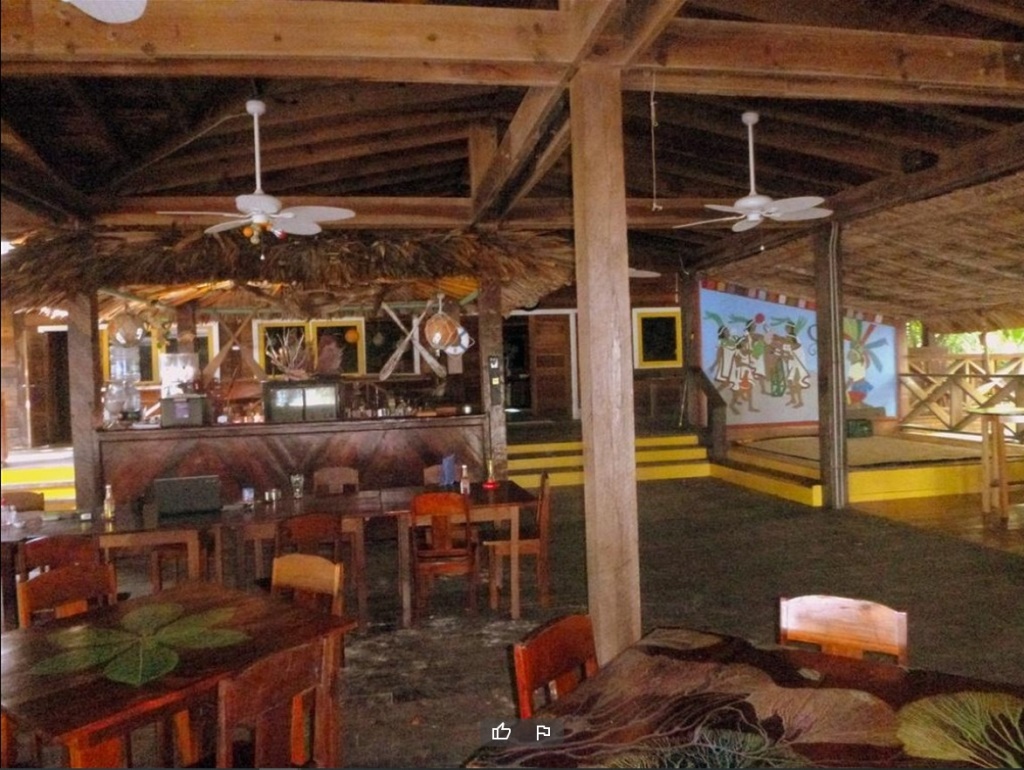
His name was Roberto, a native Belizean who turned out to not only be a pleasant fellow, but a wealth of information on diving the Blue Hole, and did not hesitate to share his knowledge. He asked me about how I knew of the Blue Hole as I was from Canada. I told him that as a kid, I saw the TV documentary of Jacque Cousteau taking his exploration ship, the Calypso into the hole and dive it with his mini sub. Roberto’s face lit up. He went on to tell me that he was there! At first, I thought it was just a boastful claim, but he went on to explain that his father guided Cousteau’s ship through the labyrinth of coral into the hole where the ship moored for a few days.
“I was only 8 years old but my father took me along!” Roberto proudly declared. We talked of his experience and by the time he finished his story, I could not doubt his sincerity. I pointed out to Maiatla swinging peacefully at anchor off in the lagoon.

“Do you think I can get my boat through the reefs and into the hole?” Roberto did not hesitate. “Yes sure, no problem just do it when the sun is high and behind you”.
We talked a few minutes more about the way in, then I departed. I regret that I did not have the forethought to take the man’s picture. I found Easton, sitting in an Adirondack style chair, looking a bit downcast as he stared out to sea.
“So kid what did the dive master have to say? Is there a course you can take?”
Without much enthusiasm he answered. “Yes, a four day course but I wouldn’t take a course from that asshole!” I was surprised by my Nephew’s response. I probed him for an explanation.
“Well first off, he seemed upset that I was trying to talk to him when he was with that girl, and he was talking big, bragging about all the diving that he’s done, think he’s trying to get laid!” Easton added. ”
I had to chuckle to myself because I had the same thought when I was talking to the pair.
“I told him I would want a course right away as my uncle and I were taking your boat out to the Blue Hole to dive.” When he heard that he laughed and said that you were crazy if you thought you could get the boat into the hole! He then said “I have made a lot of money off of people like your uncle who crash on the reefs and need saving!”
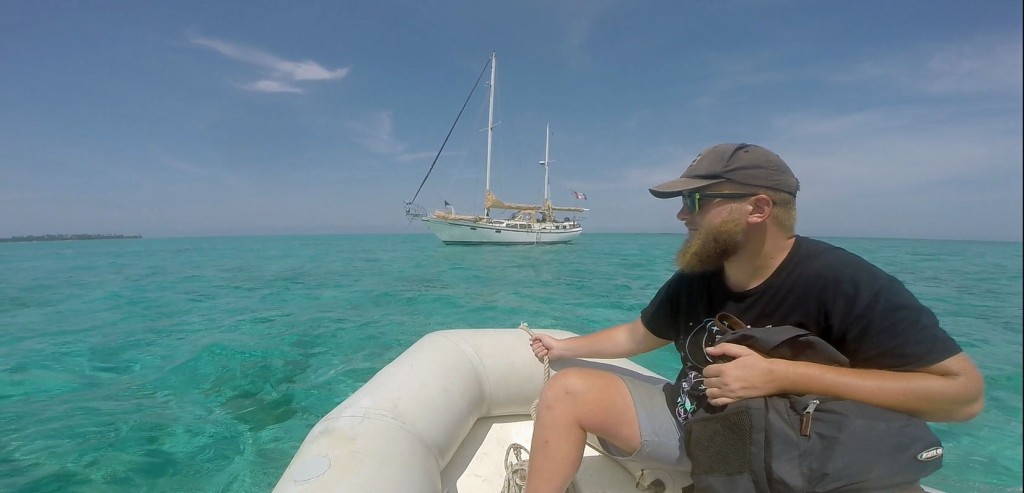
After hearing all this, Easton’s use of “asshole” seemed to appropriate.
“Well I guess he just lost a paying customer, screw him, let’s go back to the boat kid.”
As we marched down the dock, Easton hesitantly asked,
“Can you really get the boat into the Blue Hole Uncle Andy?” Yes sure kid no problem.” I said confidently. “When we come back in a few days we will stop here for a beer and to tell that dick how much we enjoyed diving the hole.”
Funny thing was that if Easton had asked this question the day before, my answer would have contained words like “maybe and try” but after talking to Roberto up on the deck, I was filled with optimism and I was excited about the prospects of the following days.
In the morning, we sailed across the lagoon to Half-Moon Caye where there was a range’s station, it was there we would have to buy a park permit before heading out to the hole. Half Moon Caye is located at the southeast corner of Lighthouse Atoll and was the first nature reserve to have been established in Belize under the National Park Systems Act in 1981 and first Marine protected area in Central America. This is also Belize’s oldest site of wildlife protection since it was first designated as a bird sanctuary in 1924 to protect the habitat of the Red Footed Booby birds. The island has an expansive sand beach and dense mangroves crisscrossed with trails taking you deep into Bobby nesting country.

The approach to the Caye is very shallow, forcing us to anchor over half a mile from shore with only inches under the keel. The island itself is spectacular, enticing you to stay for a few days to explore, but that was not our intent, not this time anyway. We would only spend a few hours ashore, wandering, but only after we purchased a two day permit to anchor out at the Blue Hole for $60 Belize dollars per day. ($30 USD).
There were only a hand full of other tourist on the island so we pretty much had the place to ourselves as we hiked to the far western most point for a swim.

I planned a snaking route through the coral using Navionics. Water depths varied from 2 to 5 meters with countless bommies lurking just below the surface. Striking the reef would be disastrous, as fines for doing so are horrendous. I met a cruiser at Nana Juana marina last year who ran aground and had to be pulled off by the Belizean Coastguard. His boat was impounded and he was forbidden to leave the country until he paid$50,000 USD fine. After months of negotiations he finally agreed to pay $19,000 USD. Despite being in the custody of the Coastguard at their privet docks, most things of value had been stripped from the boat. The cruiser vowed to never go to Belize again.
The general consensus of most cruisers is that if you run aground, never call for help, get yourself off and if your boat is going to be a total loss, grab what you can and fly out of the country as fast as you can. This was also my plan.

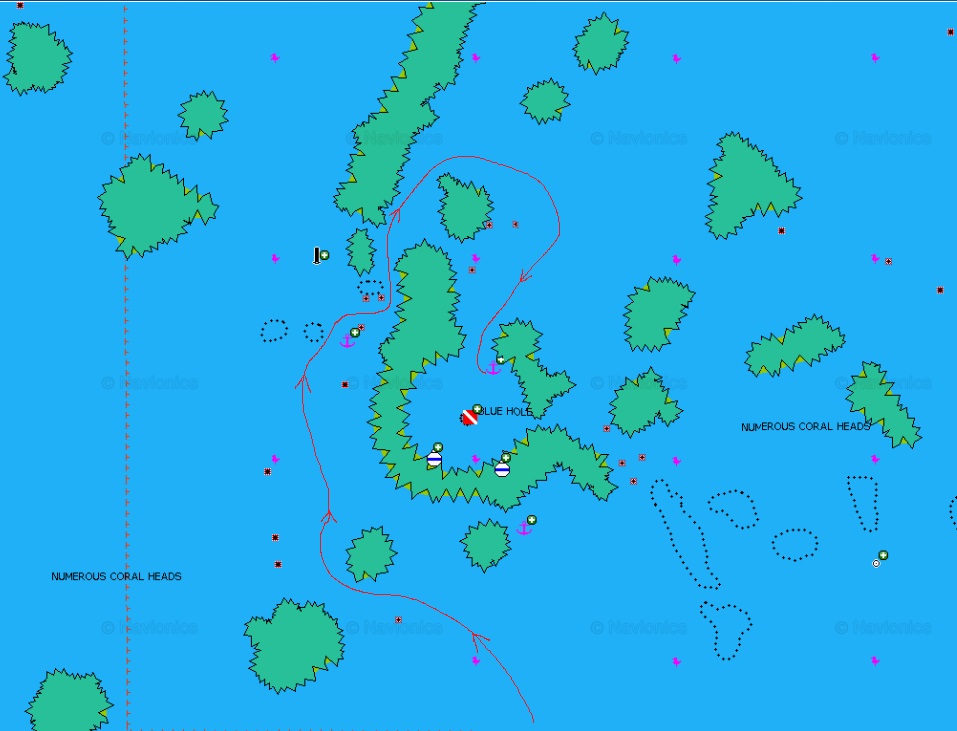
By 10am the following day we haul anchor and entered the expansive reef system. The sun was to my right and over my shoulder, the intense sun caused the sand patches to glow in stark contrast to the browns and greens of the coral heads. I was nervous but by all accounts it went well and by noon we had found our way into the Great Blue Hole, securing to one of two mooring balls located within the hole. The park ranger told me about the balls which he recommended we tie. The moorings belonged to a liveaboard dive boat, the Aggressor which visits the hole something like twice a week. It was a great mooring with a line as thick as my right arm. Once secured, I was confident that we were not going anywhere.

Our bow hovered 3 meters above a beautiful sand bottom with our stern peaking over the brim of the hole with the bottom some 150 meters below. We had hardly settled in when a sea turtle came for a visit, Easton and I quickly donned our snorkeling gear and jumped in to greet the friendly beast.
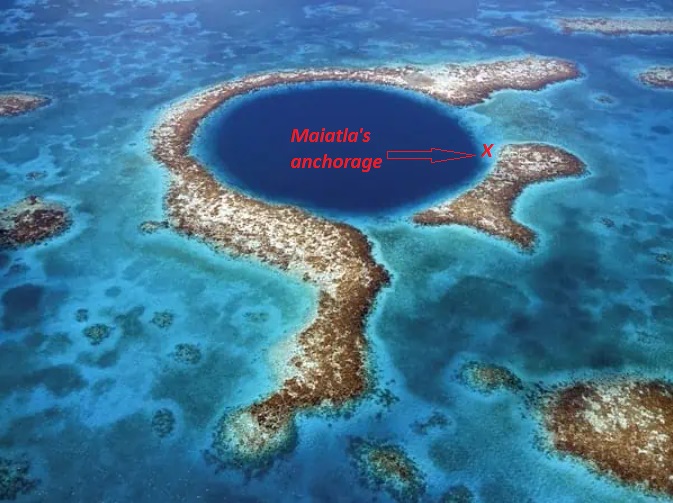
We spent the following 2 days with the place all to ourselves, snorkeling around the perimeter of the Blue Hole. The marine life and coral was magnificent and I was surprise to see much of the coral brim came within inches from breaching the surface, a condition preventing us from swimming overtop of large sections of the reef. I never did break out the scuba tanks as I was content on free diving. Besides, deep diving into the hole solo would have been a bit fool hardy. We could see several sharks cruising the depth but they never did come too close.

We had a grand time and could have stayed longer but on the morning of our 3rd day, I spotted a large vessel heading our way. It was the Aggressor what meant we had to move. We quickly dropped the mooring lines and exited the hole to attempt to anchor outside the rim in 5 meters of water. The wind had been building all morning creating whitecaps across the lagoon. I attempted to anchor but without luck. The bottom consisted of a thin layer of sand overtop a dead coral base. Poor holding and after three attempts, I decided not to risk dragging anchor and finishing up on the reef that lay a few hundred meters behind us. It was time to go.


I followed my old GPS course coming in. Now feeling confident in my course, I had Easton unfurl the headsail and sheet it in putting us on a fast broad reach. It was a spectacular way to depart the Great Blue Hole. I vowed to return next year and use the scuba gear to probe the depths.

We anchored back of the Dive resort for beers and to use the internet to tell our families of our triumphant return to civilization. Easton received some measure of satisfaction telling the dive master of his snorkeling adventures in the Blue Hole. While Easton went for more beers, I noticed Susan, the lady from Montreal sitting alone at a nearby table. I went over to say hello. I guessed that she was in her late 30s and I was surprised to hear that she was traveling alone. She had been diving daily out of the resort but she had not done the Blue hole. A shame considering that she was so close. Like us, she would be leaving the Atoll in the morning. We moved Maiatla out of the lagoon to find a quiet anchorage on the west side of long Caye where we found several lobsters that accepted Easton’s invite for diner.
